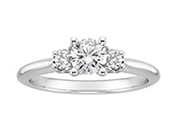How to Buy an Engagement Ring
On your mark, get set, search! The perfect ring is just a few clicks away. This guide is a great place to start.
Choose a Metal
Learn everything you need to know about the different metal types. Use our Precious Metals Guide to determine which metal is best for you and your budget.
Choose a Style

Solitaire - The classic single stone. Solitaire is the most popular engagement ring style. Round brilliant is the most popular diamond cut for a solitaire setting.

Halo - A halo style setting features a center stone surrounded by a halo of round pavé or micro-pavé diamonds that enhance the appearance of the center stone. It is the second most popular engagement ring style, next to solitaire.

3-Stone - A three stone engagement ring is sometimes referred to as a trinity ring or trilogy ring. The three stones represent the past, present and future of a relationship.

Multi-stone - Also known as a diamond cluster ring, a multi-stone ring features multiple diamonds grouped together to form a center stone.

Vintage - Vintage-inspired styles borrow elements of design from the past. Think of it as an instant heirloom.
Know the Four Cs
Once you've decided on a style, it's time to learn about diamond color, cut, clarity and carat. If you aren't already familiar with the Four Cs now's the time to read up on them so you will be able to make an informed decision when you are ready to choose your diamond.
Choose the Right Size
The most common ring size for women is 6. The best way to get the most accurate size for you is to visit one of our store locations for a free ring sizing. You can also view our ring size guide (PDF).
Before you start shopping, it's wise to set a budget. Your budget will guide your shopping journey i.e. all of your decisions going forward. Once a budget has been established, you can begin thinking about your priorities as they relate to cut, color, carat weight and clarity. For example, if you have your heart set on a two carat diamond, you may have to go down a few color grades or clarity grades to stay within budget. That's because the larger the diamond, the rarer and more expensive it is. (As a rule of thumb, cut is one quality factor you shouldn't compromise on as it has the biggest impact on a diamond's brilliance, fire and sparkle.) When setting a budget, keep this in mind: there's no magic number, as in no right or wrong amount to spend on an engagement ring. You may have heard a rule suggesting you spend two months' or even three months' salary on your engagement ring. We recommend a more personalized approach. Since you'll likely spend a greater portion of your budget on the diamond, learn about how cut, color, carat weight and clarity affects price. Consider factors like monthly income and expenses, and where the purchase fits in with other major purchases, like buying a house or car. Traditionally, purchasing an engagement ring is one of the first big financial decisions a couple makes together. Spend as much as you can comfortably afford.
Engagement rings come in a variety of metals, e.g., yellow gold, white gold, rose gold, platinum and silver. Each metal type has advantages and disadvantages. Platinum, for example, is denser than gold, meaning it's more durable. It also means a platinum setting will cost more than a gold setting of the same size, because it weighs more. When it comes to making a decision about which metal type is right for you, factors to consider include lifestyle and budget.
There are thousands of ring settings to choose from, and styles, like metals, have pros and cons. When choosing a setting, keep your lifestyle in mind. Prong settings, the most common type of engagement ring setting, utilize prongs, or claws, to hold the diamond in place. Most prong settings feature either four or six prongs, which also elevate the diamond so it can be admired. More prongs offers better protection; however, the addition of prongs does affect a diamond's appearance. Six prongs hold a diamond more securely but can crowd a smaller stone. And while six prongs can actually make a round shaped diamond look rounder, a six prong setting can make some diamonds appear smaller, since more of the diamond's surface is covered by prongs. If you have an active lifestyle or a job that requires constant use of your hands (e.g., you're an agriculturer, medical professional or hair stylist) you may want to avoid high-set prong settings and opt for low-profile designs. Lower prong settings are easier to fit into gloves, meaning they're more practical for people who work in hospitals, labs, etc., and the closer your diamond is to sitting flush with the band, the less likely it is to scratch someone, get caught in your hair or snag your clothes.
Lastly, don't forget about the wedding band. When choosing an engagement ring, if you plan to wear it stacked with your wedding ring (as opposed to wearing it on the right hand or only wearing it only on special occasions), pick one that accommodates a second band (preferably in a complementary style and color).



